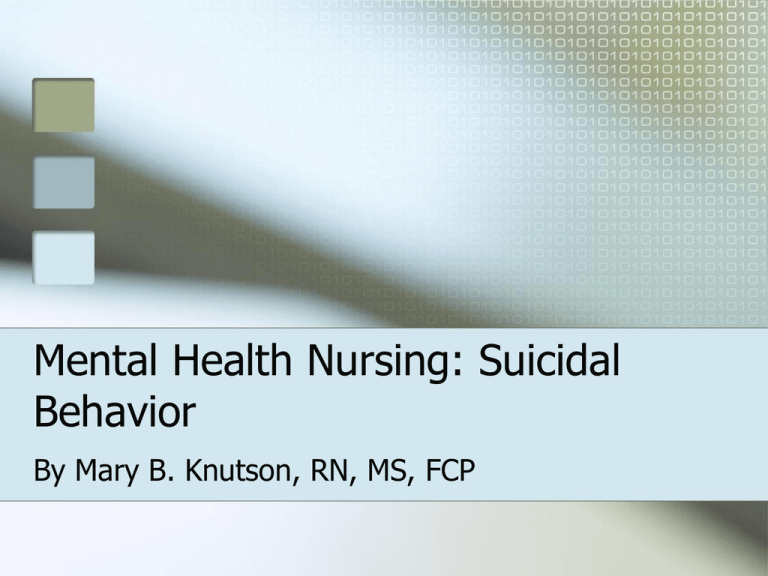Mental Health Nursing: Anxiety Disorders
advertisement

Mental Health Nursing: Suicidal Behavior By Mary B. Knutson, RN, MS, FCP Self-Protective Responses Protection and survival are fundamental needs of all living things Life is characterized by risk Individuals choose the amount of potential danger to expose themselves to Low self-esteem leads to depression, which is always present in self-destructive behavior Self-Destructive Behavior Any form of suicidal activity, such as suicide threats, attempts, gestures, and completed suicide Self-Protective Response Continuum Adaptive responses Self-enhancement Growthpromoting risk taking Indirect self-destructive behavior Maladaptive responses Self-injury Suicide Comorbidity of Suicidal Behavior Affective disorders Substance abuse Schizophrenia Panic disorder Adolescents who kill themselves tend to have depression and conduct disorders Suicide Statistics About 30,000 people complete the act of suicide each year, making it the eighth leading cause of death in the U.S. 71% occur among white males 19% occur among white females Rates increase between ages 15-24, and among people over 65 years old (especially age 75-85) Suicide Attempts Males use guns most of the time Women usually use medication overdose or wrist slashing Use of guns is increasing Assessment of Behaviors Noncompliance Denial of seriousness of illness Increased anxiety because illness may signify “getting old” Struggle for control Self-injury- Causing deliberate harm to one’s own body (cutting or burning skin, banging head and limbs, picking at wounds, or chewing fingers) Definition of Suicidal Behavior Self-directed actions that will lead to death if not interrupted Nurse should ask patient if he has a plan to hurt himself, and what the plan is – knowledge will help plan care “I understand that you are feeling impulses to harm yourself. I will do whatever is necessary to protect you and keep you safe. I’d like to talk with you about how you are feeling when you are able to share that with me.” Predisposing Factors Genetic and family history Psychiatric diagnosis, personality traits and disorders Psychosocial and environmental factors Biochemical factors Contribute to biopsychosocial model for understanding self-destructive behavior over the life cycle Increased Risk for Suicide Suicide Risk Factors Personality Traits Hostility Impulsivity Depression History Psychosocial Hopelessness Caucasian male Advanced age Living alone Prior suicide Diagnostic attempts General medical Family history of illness suicide attempts or substance Psychosis abuse Substance abuse Medical Diagnosis Bipolar disorder Major Depressive Noncompliance with treatment Schizophrenia Substance use disorders Examples: Nursing Diagnosis High risk for self-mutilation r/t feelings of tension and worthlessness e/b cutting legs Noncompliance with diabetic diet related to denial of illness e/b wt gain of 20 lb Potential for self-directed violence r/t drug abuse e/b extreme psychotic disorganization and lack of body boundaries Nursing Interventions Protecting the pt Contracting for safety Increasing self-esteem Regulating emotions and behaviors Mobilizing social support Mental health education Suicide prevention Nursing Care Plan Highest priority is given to life-saving patient care activities. The patient’s behavior must be supervised until self-control is adequate for safety. Observe closely Remove harmful objects Provide a safe environment Provide for basic physiological needs Contract for safety, if appropriate Administer and monitor medications Evaluation Patient Outcome/Goal Patient will not physically harm oneself Nursing Evaluation Was nursing care adequate, effective, appropriate, efficient, and flexible? References Stuart, G. & Sundeen, S. (1995). Principles & practice of psychiatric nursing (5th Ed.). St. Louis: Mosby






